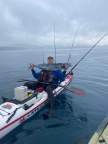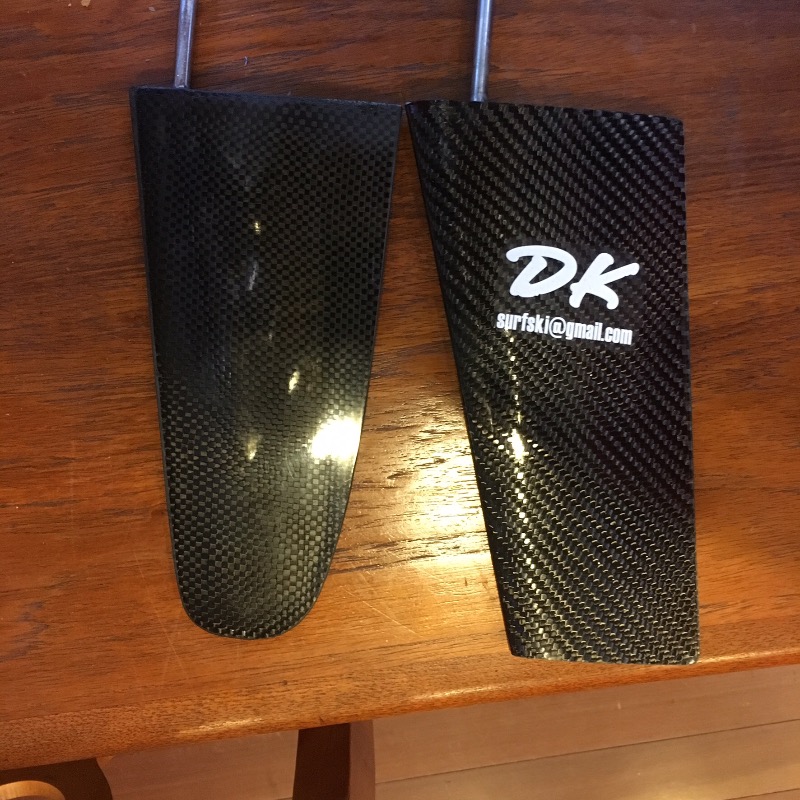- Posts: 565
- Thank you received: 85
Improving Stellar SR G1 rudder
- MCImes
- Topic Author
- Visitor
I have read the Stellar SR G1 stock rudder is not the greatest (mine is approx 2008 vintage for reference). My experience confirms this, as I feel the boat broaches easily even when under maximum rudder, and also the rudder has a "mushy" feel. The response is not crisp. I feel it has 'give' in it before it corrects.
1. I have heard a different rudder improves the response of the boat. What is your preferred rudder? (brand or style)?
2. Would replacing the rudder lines with stainless cable improve the mushy feeling? or some other solution?
Any other thoughts on how to improve the SR G1 rudder?
Thanks in advance!
Please Log in or Create an account to join the conversation.
Please Log in or Create an account to join the conversation.
The second series is better and for flat water racing they are actually quite good, - their narrow profile generating very little drag in circumstances where only small changes of direction are required.
For downwind racing however, they have four problems: Sweep, Taper, Depth, & Profile.
The sweep (almost 30 degrees) means that as the stern of the ski comes out of the water when you're on a runner, steering effectiveness reduces dramatically because the amount of rudder in the water reduces at an even greater rate.
The taper of the rudder (from 130mm at the top to 50mm at the base) conspires with the sweep to further reduce the rudder's active surface area when on a wave.
At 200mm in depth, the standard rudder (particularly in conjunction with its sweep and taper) is marginal at best. For downwind conditions, a 230mm depth would be more effective.
Finally, the profile of the standard Stellar rudder is great for reduced drag at straight ahead or shallow turning angles, but not for manoeuvrability on runners. The narrower the profile of a rudder, the lower the angle of attack before it "stalls". (A rudder is simply a wing that generates "lift" in the direction of turn.)
If you take measurements of the Stellar rudder and plug those into a rudimentary CFD program, you'll probably find it produces its greatest lift (turning force) at about 15 degrees AoA. Beyond that, the lift drops dramatically and becomes zero (stalls) before 20 degrees. At this point, the rudder becomes virtually ineffective except as a "brake" simply slowing the craft down until the flow reattaches, at which point the rudder will suddenly "bite" again.
By increasing the width of the rudder by just a few mm, lift at the same angle of attack can be increased, more angle can be used before lift drops away and the onset of stall delayed to probably 25 degrees.
Yes, drag will be increased with a "fatter" rudder because of both increased frontal area and increased wetted surface area, but in downwind conditions, this would be more than offset by the added manoeuvrability and "surfability" afforded by a different rudder.
Sorry, - that was a (very) long-winded way of saying that you need a larger rudder with a different shape and profile to be effective in downwind scenarios.
Try Peter from Orka in South Africa. I put one of his rudders on an SES and it transformed the boat in lumpy conditions, particularly when having to work diagonally across the direction of the swell to get to the finish point.
Please Log in or Create an account to join the conversation.
Please Log in or Create an account to join the conversation.
- MCImes
- Topic Author
- Visitor
Please Log in or Create an account to join the conversation.
( surfski@gmail-dot-com) and get a rudder from him.
I never liked my Stellar rudder and it was a balanced one, not the first gen with the post up front. I have strong feelings about Stellar rudders (and most other manufacturers) and the standard 8” and the newer 9” Downwind rudder suck imho. They have terrible leading edges and it’s ALL about the leading edge... well, mostly. I swapped the 8” standard rudder in my first gen SR to a 9” 15° "gorge special" from Don and it totally changed the behavior of the ski. No more broaching, much more precise and immediate controle and much improved ability to surf diagonally, night and day really. This apply to my current gen SR as well. It seriously changed that ski from being a below average surfer with the 8” rudder to a super one with the same 9” 15° "gorge special". I have had a bunch of his rudders over the years and they have never failed to preform better than stock rudders on ever ski I have used them on. Some more than others but transformative In my Stellar skis. Also a big improvement in my Swordfish S over the stock 8”.
Here is a couple of photos of a DK 9 inch 15° wide cord "gorge special" that lives on my SR. It’s compared to the Stellar 9” Downwind rudder. Honestly I never got to test the Stellar rudder as it wouldn’t fit the new SR I had just bought as the shaft was too big and wouldn’t fit in the ski. But, I would venture a guess that it wouldn’t preform well as the leading edge is a totally and unacceptable mess. It literally has a pointed edge from being run on a belt sander with two facets. The pictures don’t really show just how bad it is. It’s garnered to loose flow over the rudder the moment you furnish it much and will most likely stall quickly and induce broaching. Compare with the perfect NACA foils leading edge on the DK rudder (on the left) ... it’s night and day and you can feel it on the water. Don now offers quite a few options who talk to him and se what he recommends now. I’m totally happy with the 9” 15° wise cord "gorge special" for a proper big Downwind rudder. It’s a big rudder and is aggressive but the SR is so stable it’s great. Swap it to my SEL and it’s light with the toes or it will throw you out of the ski. But he can make what ever you want.
FENN Bluefin S
FENN Swordfish S carbon hybrid
Epic V8 double gen 2
Lot and lots of DK rudders.
Had:
Stellar SEL excel (gen 2)
Stellar SR excel (gen2)
Stellar S18s g1 (excel)
Epic V10 Double (performance)
Stellar SR (gen 1)
V10 sport (gen 2)
V10 (Gen 2)
Beater SEL (gen 1)
Please Log in or Create an account to join the conversation.
To start with, it is the ugliest rudder I have ever used. It is ridiculously thin.
Secondly, I think it is actually faster than the standard rudder. There is no discernible difference between the standard rudder and the surf rudder with regard to drag, and if anything may feel slightly quicker in the water. Previously I was using a modified Epic rudder, but was reluctant to use it because unless the wind was howling it simply slowed the boat too much.
I have used the new rudder a couple of times in small- moderate downwind paddle and it controls the boat well. It definitely adds to the primary stability of the boat and definitely improves the tracking of the boat. The best part is that I just leave it on he boat full time now without any drag penalty. Thought this may be of interest.
Please Log in or Create an account to join the conversation.
Post beforehand of Newbflat absolutely spot on! Hey love that table timber under your Keising rudders - looks like our West Australian jarrah, surely none in Seattle? While stability difference for me between the surf Keising and surf Stellar is indeterminate, control difference is enormous! As I've been out of action from shoulder op for almost four months now (sigh) I haven't used the larger Keising rudder in big conditions. My initial concern yet to be determined is its steep angle and potential weed collecting. However the smaller standard rudder a huge improvement - much more immediate response, didn't stall in wind up to 20 knots.
Please Log in or Create an account to join the conversation.
Not jarrah, it’s Teak. But you can get Jarrah here and I have mane some bookshelves with the stuff... it lovely.
Oh yeah, it’s a weed magnet for sure. That’s just the trade off for a long straight and steep leading edge. In exchange you get more aggressive and precise steering do to powerful lift. The Stellar 9” Downwind rudder is even steeper than the DK. But it’s so thin with a strange thickness taper that doesn’t look like a proper NACA (4 digit) foil and the leading edge such a mess it’s all wasted. The other thing I like about DK rudders is the last 2 inches or so of the rudder is not elliptical. When that rudder is in the air in short steep waves and only the tip touches the water the DK rudder has more power.
FENN Bluefin S
FENN Swordfish S carbon hybrid
Epic V8 double gen 2
Lot and lots of DK rudders.
Had:
Stellar SEL excel (gen 2)
Stellar SR excel (gen2)
Stellar S18s g1 (excel)
Epic V10 Double (performance)
Stellar SR (gen 1)
V10 sport (gen 2)
V10 (Gen 2)
Beater SEL (gen 1)
Please Log in or Create an account to join the conversation.
- MCImes
- Topic Author
- Visitor
Till then ill just look at the water with lusty eyes and watch millers run videos
Please Log in or Create an account to join the conversation.
The one thing I would question is whether the thickness of the rudder is as noticeable as suggested. A reasonably clean rudder should not account for more than 5% of total drag of the ski and even doubling the thickness from 8% to 16% (the very extremes of thickness should not vary the rudder drag by more than 20%. By implication it is being suggested that drag differences of 1% are readily felt.
Please Log in or Create an account to join the conversation.
- owenfromwales
-

- Offline
- Elite Member
- Posts: 252
- Thank you received: 31
189cm 90~100kg
Present skis:
2017 Stellar SEI 2G
1993 Gaisford Spec Ski
1980s Pratt Spec Ski
1980s UK Surf Skis Ocean Razor
Previous
1980s UK Surf Skis Ocean Razor X 3
1987 Kevlar Chalupsky (Hummel) (Welsh copy!)
1988 Kevlar Double Chalupsky
1992 Hammerhead spec
2000 Fenn copy
Please Log in or Create an account to join the conversation.
Another problem with G1s is the whole placement in the pedals. They are spaced too far apart. This can be fixed with a simple mod using a piece of plastic with a couple of holes drilled in it. I found this mod here at Surfski.info years ago so it will probably be floating around in archives somewhere.
Cheers
Please Log in or Create an account to join the conversation.
www.surfski.info/forum/26-other/6711-stellar-v-epic.html#6746
You will find some images of the mod at Wesley Echols website surfskiracing.com.
Have a look at his stellar SEL review cica sep 2011.
Cheers
Please Log in or Create an account to join the conversation.
Latest Forum Topics
-
- Nelo models getting confusing
- 2 days 9 hours ago
-
- Fenn Fenix Cuda First Impressions
- 6 days 1 hour ago


